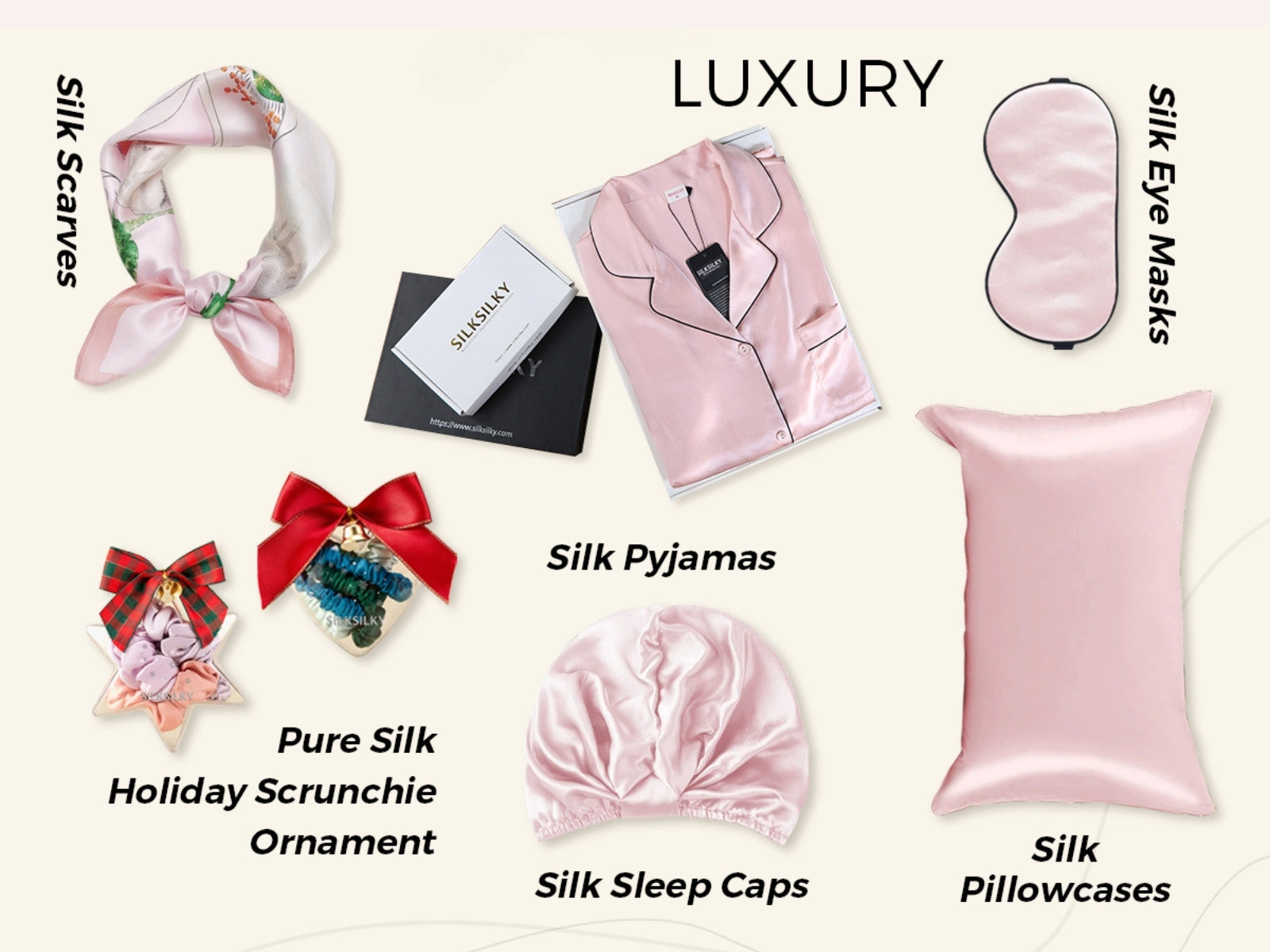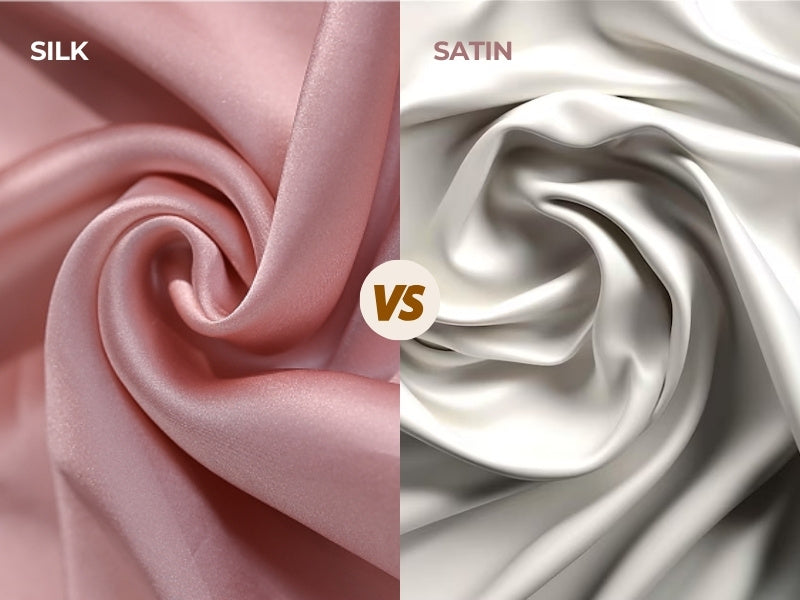Silk Bonnet Benefits for Curly Hair: Tips to Prevent Frizz Overnight
Table of Contents
- What Is a Silk Bonnet and Why Use It?
- Does Silk Really Protect Curly Hair? Here's the Science
- Top 5 Silk Bonnet Benefits for Curly Hair
- How to Use a Silk Bonnet: 3 Guiding Tips
- Silk Bonnet vs Other Overnight Hair Protection Methods
- How to Take Care of Your Bonnet
- Start Using Silk Bonnets for Curly Hair Tonight
- Frequently Asked Questions About Silk Bonnets for Curly Hair
Your curls look amazing when you style them, but by morning they're a complete disaster - sound familiar? This frustrating cycle of great hair turning into a frizzy mess happens because regular pillowcases create friction that roughens your hair cuticles and disrupts your curl pattern.
A silk bonnet creates a protective barrier that keeps your curls intact while you sleep, and the silk bonnet benefits extend far beyond just convenience. What seems like a small change to your bedtime routine can actually solve some of the biggest curly hair problems you face every single day.

What Is a Silk Bonnet and Why Use It?
A silk bonnet is a loose-fitting cap made from natural silk that protects your hair while you sleep. It creates a smooth barrier between your hair and pillowcase, preventing the friction that causes frizz and tangles overnight.
A real silk bonnet uses natural fibers from silkworms, which are naturally smooth and breathable. Satin bonnets are made from synthetic materials like polyester and don't offer the same benefits. Cotton caps actually absorb moisture from your hair and create more friction.
Protective hair coverings have been used for generations, especially in African and Caribbean cultures, to maintain natural hair health and texture. Today, silk bonnets are essential for anyone looking to improve their natural hair care routine.
Here's who benefits most from using silk bonnets:
- All curl types - from loose waves to tight coils
- Natural hair that needs gentle, chemical-free protection
- Chemically treated hair including colored, relaxed, or permed styles
- Anyone with fragile hair prone to breakage and damage
- People tired of morning frizz and flattened curls
This simple addition to your routine works regardless of your hair texture, making mornings much easier for everyone.
Does Silk Really Protect Curly Hair? Here's the Science
Curly Hair Breaks More Easily
Yes, silk really works, and the science is pretty straightforward. Curly hair is naturally weaker than straight hair because of its structure. Every twist and turn in your curls creates thin spots where the hair can snap more easily. Plus, the oils from your scalp have a harder time traveling down curly strands, so your hair stays drier and more fragile.
What Friction Does to Your Hair at Night
Friction causes most of the damage you see in the morning. Cotton pillowcases have rough fibers that catch and pull on your hair cuticles - that's the protective layer on each strand. This hair cuticle damage is what creates frizz, tangles, and eventual breakage. Cotton pillowcases also soak up moisture like a sponge, pulling hydration right out of your hair while you sleep.
How Silk Actually Works
Silk has completely smooth protein fibers that let your hair slide around without getting caught. This gives you true friction-free hair care all night long. Instead of absorbing moisture like cotton does, silk's tight weave helps with moisture retention by keeping water in your hair where it belongs. The silk protein benefits come from this naturally slippery surface that doesn't grab onto your strands.
The pH Factor
Silk has a pH between 6.5-7.5, which works well with your hair's natural pH of 4.5-5.5. This means silk won't throw off your hair's natural balance or make it drier. Hair specialists recommend silk because it doesn't cause static electricity and won't irritate sensitive scalps like some synthetic materials can.
Top 5 Silk Bonnet Benefits for Curly Hair
1. Minimizes Tangles and Frizz
The smooth silk surface prevents bed head that creates frizz while you sleep. Instead of waking up to a tangled mess, your hair stays smooth and manageable. You can literally reduce frizz overnight without any products or treatments - just by switching what's touching your hair for 8 hours.
2. Preserves Curl Pattern and Definition
Silk bonnets hold in your curls so that they stay in their A.A. form rather than pressed flat on harsh pillowcases. Your curl pattern remains undisturbed throughout bedtime until morning, so you awaken with nicely defined, springy curls rather than uneven or crushed parts. That is particularly critical for individuals whose curl patterns are loose and tend to lie flat.
3. Halt Split Ends and Hair Breakage
The soft, friction-free setting within a silk bonnet won't cause hair to snap or break. Because there is no harsh texture tugging at your hair, you won't end up with so much hair in your comb, nor so divided ends in the end. That leaves your hair actually growing longer while simultaneously becoming healthier.
4. Preserves Hairstyles Longer
No matter if you wear wash-and-gos, twist-outs, or beautifully constructed curls, a silk bonnet makes styles last fresh for days rather than a day. Your style is fresher for longer periods of time, for less time spent and less frequent retouching.
5. Less Need for Frequent Restyling
Having less manipulation of the hair in the mornings implies you don't have to style in the mornings at all. Most individuals should only rejuvenate their curls with a spray bottle rather than totally restyle, implying healthier hair in addition to a few minutes in your day.

How to Use a Silk Bonnet: 3 Guiding Tips
1.Prepare Your Hair Before Bed
Step 1: Detangle carefully. Use a wide-tooth comb and start at the very ends of your hair. Work in small sections, moving up only 2-3 inches at a time until you reach your roots. Never start combing from the top - this creates more tangles and breaks your hair.
Step 2: Add light moisture. Spray or apply a small amount of leave-in conditioner to your palms, then scrunch it into your hair. Use about a quarter-size amount for shoulder-length hair, less for shorter hair. Your hair should feel soft but not wet or sticky.
Step 3: Pick your overnight style. Choose based on what your hair needs - more definition, volume, or just protection.
2.Style Your Hair Before Putting On the Bonnet
- Pineapple Method: Flip your head upside down and gather all your curls at the very top of your head - imagine where a pineapple's leaves would be. Use a silk or satin scrunchie (never a regular elastic) and make the ponytail loose enough that you can fit two fingers underneath. The pineapple method curly hair approach works best for medium to long hair.
- Twisting Method: Part your hair into 4-8 sections depending on thickness. Take each section and twist it loosely from root to tip, then pin the end with a small clip. The twists should look relaxed, not tight like rope.
- Plopping Method: Lay a cotton t-shirt flat, flip your wet curls onto the center, wrap the shirt around your head like a turban, and leave for 15-20 minutes. Remove the shirt right before putting on your bonnet.
- Medusa Clipping: Use 6-10 small clips to lift random sections of hair at your roots. The clips should hold hair up and away from your scalp without pulling tight.
3.Put On and Secure Your Bonnet
- Check the size first. Your bonnet should cover all your hair without stretching tight across your forehead. The elastic should sit behind your ears, not on top of them. If you get red marks or headaches, the bonnet is too small.
- Put it on correctly. Hold the bonnet with both hands, stretch it slightly, and pull it over your head from front to back. Tuck all loose pieces inside, but don't compress your curls flat. Leave some room for your hair to move naturally.
- Prevent slipping overnight. Make sure the elastic band sits in the groove behind your ears. If you're a restless sleeper, try adjustable bonnets with ties instead of just elastic. Some people sleep better with a silk pillowcase as backup protection in case the bonnet shifts during the night.
Silk Bonnet vs Other Overnight Hair Protection Methods
When it comes to protecting your hair while you sleep, here are your main options and how well they actually work:
Silk Pillowcase
A silk pillowcase reduces friction on whatever side of your head touches it. This helps prevent frizz and tangles on that area, but if you move around at night, the rest of your hair still rubs against regular sheets or gets crushed. It's the easiest method since you don't have to do anything different, but it only gives you partial protection.
Satin Bonnet
Satin bonnets cover your entire head like silk ones do, so all your hair gets protection from friction and moisture loss. They work well for overnight hair protection and stay put through the night. The main difference is that synthetic satin can make your head feel warmer and sometimes creates more static than natural silk.
Silk Scarf Wrap
A properly tied silk scarf protects all your hair from friction, similar to a bonnet. It works especially well for long or very thick hair that might not fit in standard bonnets. The problem is getting it tight enough to stay on but loose enough to be comfortable - this takes practice and many people give up before mastering it.
Hair Plopping with Microfiber
This method only works for wet hair and isn't meant for sleeping. You wrap damp curls in a microfiber towel for 15-30 minutes to help them dry without frizz. It's not a true overnight protection method since you remove the towel before bed.
| Method | Full Hair Protection | Stays Put All Night | Easy to Use |
| Silk Bonnet | ✓ | ✓ | ✓ |
| Silk Pillowcase | Partial | ✓ | ✓✓ |
| Satin Bonnet | ✓ | ✓ | ✓ |
| Silk Scarf | ✓ | Sometimes | Hard |
| Microfiber Plopping | N/A | N/A | ✓ |
How to Take Care of Your Bonnet
Proper care makes your silk bonnet last years instead of months, so these steps are worth following.
- Hand wash in cool water every 1-2 weeks with gentle soap or silk detergent
- Never use bleach, fabric softener, or harsh chemicals - they destroy silk fibers
- Rinse thoroughly and gently squeeze out water - don't wring or twist the silk
- Air dry completely before storing - heat from dryers ruins silk
- Store in a breathable cotton bag or drawer - plastic bags trap moisture and cause damage

Start Using Silk Bonnets for Curly Hair Tonight
Silk bonnets really do work - the smooth fibers prevent frizz and keep your curls intact while you sleep. Instead of waking up to a tangled mess every morning, you can preserve your curl pattern and cut your styling time in half. A quality silk bonnet costs less than a single salon visit but gives you benefits for years. Try it tonight and see the difference silk bonnet benefits can make for your curly hair routine.
Frequently Asked Questions About Silk Bonnets for Curly Hair
Q1: Can I wear a silk bonnet with wet hair?
No, don't put a bonnet on soaking wet hair. This traps too much moisture and can cause mold or bacteria growth. Let your hair air dry for at least 30 minutes first, or until it's about 70% dry. Slightly damp hair is fine, but never completely wet.
Q2: How often should I replace my silk bonnet?
Replace your silk bonnet every 2-3 years if it's good quality mulberry silk. Get a new one sooner if the elastic stretches out, you see holes or tears, or it stops staying on your head during sleep. When the fabric feels rough instead of smooth, it's time for a replacement.
Q3: Can I sleep on my side or stomach while wearing a silk bonnet?
Yes, you can sleep in any position with a silk bonnet on. The bonnet moves with your head and doesn't require you to change how you sleep. Side and stomach sleepers actually get more protection because their hair would normally rub against the pillow more.
Q4: Will a silk bonnet work for short curly hair?
Yes, silk bonnets work great for short curly hair. Even very short cuts like pixie styles benefit from reduced frizz and moisture protection. Short curls often get flattened more easily against pillows, so bonnets can actually help more than with longer hair.
Q5: Can men use silk bonnets too?
Yes, silk bonnets work for anyone with curly hair. Many men use them to protect waves, curls, locs, or natural hair textures. The hair benefits are the same regardless of gender - less frizz, better curl definition, and healthier hair.
Q6: Can I use leave-in products with my silk bonnet?
Yes, but use small amounts. Apply leave-in conditioner or light oils before putting on the bonnet. Avoid heavy creams or thick gels that can make the bonnet slip off or get the silk fabric dirty. Less is more when it comes to products under bonnets.
Q7: Do silk bonnets help with hair growth?
Silk bonnets don't make hair grow faster, but they prevent breakage that makes hair look like it's not growing. When your hair breaks less, you keep more length over time. This means better length retention, not faster actual growth.
Q8: Can I wear a silk bonnet if I have scalp conditions like dandruff?
Yes, silk is gentle and won't irritate sensitive scalps like synthetic materials can. Just wash your bonnet more often - every 3-4 days instead of weekly - to keep it clean. Silk is naturally hypoallergenic, so it's actually a good choice for scalp issues.
Q9: What should I do if my silk bonnet keeps slipping off?
First, check if your bonnet is too big. Most slipping happens because the bonnet is the wrong size. If the size is right, try bonnets with adjustable ties instead of just elastic bands. You can also use a silk pillowcase as backup in case the bonnet moves during sleep.
![[Light Blue] SilkSilky Pure Silk Notch Collar Women's Pajamas 001,](http://silksilky.com/cdn/shop/files/ab83afb9301666ee2f174a8ae72ffda4_4e9bb488-7880-40fe-9e69-f0fd823857c5.jpg?v=1764653199&width=1200)
![[Light Blue] SilkSilky Pure Silk Notch Collar Women's Pajamas 002,](http://silksilky.com/cdn/shop/files/db8dbeee5354fe3b631b963715847ffe.jpg?v=1764653202&width=1200)
![[Dark Red] SilkSilky Pure Silk Notch Collar Women's Pajamas 001,](http://silksilky.com/cdn/shop/files/599ed0811e1a5fcfa55bdc80a0279704_2643c850-a793-4475-a52b-7fef1bbd7e36.jpg?v=1762233837&width=1200)
![[Dark Red] SilkSilky Pure Silk Notch Collar Women's Pajamas 002,](http://silksilky.com/cdn/shop/files/9e022d4dd4f99aed4af8da3f58fcfd5b_efb9bafe-3d71-4283-9b81-e339ff08f352.jpg?v=1762233837&width=1200)
![[White] SilkSilky Pure Silk V Neck Nightgown 001,](http://silksilky.com/cdn/shop/files/a8ae95260a57844b1e2e00c4fcfabdcc_b922b270-af10-4e96-9493-0d877bd663db.jpg?v=1764140639&width=1200)
![[White] SilkSilky Pure Silk V Neck Nightgown 002,](http://silksilky.com/cdn/shop/files/24ac506750f8c38c51bb5b6d0ee15287.jpg?v=1764140639&width=1200)
![[Pink] SilkSilky Pure Silk Sleep Cap 001,](http://silksilky.com/cdn/shop/files/SilkSilky_Pure_Silk_Sleep_Cap_Pink_001_C-250529006.jpg?v=1762221980&width=1200)
![[Pink] SilkSilky Pure Silk Sleep Cap 002,](http://silksilky.com/cdn/shop/files/SilkSilky_Pure_Silk_Sleep_Cap_Pink_002_C-250529006.jpg?v=1762221980&width=1200)
![[Champagne] SilkSilky Pure Silk Round Neck Women's Pajamas 001,](http://silksilky.com/cdn/shop/files/4cd008b260b48a735910ef47a0ffcede_154de09c-492d-4405-a783-c5caa649ff51.jpg?v=1762322738&width=1200)
![[Champagne] SilkSilky Pure Silk Round Neck Women's Pajamas 002,](http://silksilky.com/cdn/shop/files/322ae8e3d97b01938181e0aae5a68459.jpg?v=1762322738&width=1200)






